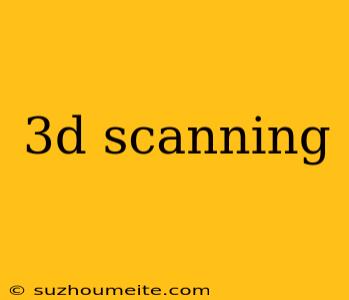3D Scanning: The Technology that Revolutionizes Data Capture
Introduction
3D scanning is a technology that has been gaining popularity in recent years, and for good reason. It allows us to capture detailed and accurate data about the physical world, creating a digital representation of objects, people, and environments. In this article, we'll explore the world of 3D scanning, its applications, and the benefits it brings.
What is 3D Scanning?
3D scanning is the process of capturing data about an object or environment using sensors, lasers, or other technologies. This data is then used to create a digital model, often in the form of a point cloud or mesh. The resulting model can be used for a variety of purposes, including analysis, visualization, and simulation.
Types of 3D Scanning Technologies
There are several types of 3D scanning technologies, each with its own strengths and weaknesses. Some of the most common include:
Structured Light Scanning
Structured light scanning uses a projector to cast a pattern of light onto an object. The deformation of this pattern is then captured by a camera, allowing for the creation of a detailed 3D model.
Laser Scanning
Laser scanning uses a laser to capture data about an object or environment. This technology is often used in surveying and engineering applications, where high accuracy is crucial.
Photogrammetry
Photogrammetry uses multiple cameras to capture images of an object or environment from different angles. These images are then combined to create a 3D model.
Applications of 3D Scanning
3D scanning has a wide range of applications across various industries, including:
Product Design and Manufacturing
3D scanning is used to capture data about existing products, allowing designers to create digital models and make changes before prototyping.
Architecture and Construction
3D scanning is used to capture data about buildings and environments, allowing architects and engineers to create detailed models and simulations.
Healthcare
3D scanning is used in healthcare to create detailed models of the human body, allowing for personalized treatment and analysis.
Benefits of 3D Scanning
The benefits of 3D scanning are numerous, including:
Increased Accuracy
3D scanning allows for highly accurate data capture, reducing errors and improving decision-making.
Improved Efficiency
3D scanning can reduce the time and cost associated with traditional data capture methods.
Enhanced Visualization
3D scanning allows for the creation of detailed and interactive 3D models, enhancing visualization and understanding.
Conclusion
3D scanning is a powerful technology that has the potential to revolutionize the way we capture and utilize data. Its applications are vast, and its benefits are undeniable. As the technology continues to evolve, we can expect to see even more innovative uses of 3D scanning in the future.
